Cameroon is constructing a new 420-megawatt capacity hydroelectric dam in Batchenga, aiming to reduce the country’s significant energy deficit by 30%.The massive dam project is impacting several villages where fishing is an essential part of the local economy. Several professional bodies, including fishmongers, fishermen and restaurant owners, have lost their livelihoods due to the dam’s construction.Fishmongers in one nearby village, Ndji, are becoming increasingly desperate for proper compensation as the amounts paid by the Nachtigal Hydro Power Company is not enough to make ends meet, they say.Civil society organizations are also accusing Nachtigal of seriously violating environmental standards during dam construction, despite the company continuously receiving environmental compliance certificates by the government.
NDJI, Cameroon – Batchenga, 65 kilometers (40 miles) northeast of Cameroon’s capital Yaoundé, is slowly reopening. After serving as a ramp at the start of a national road linking the center region and Adamaoua in the north, it now owes its reputation to the construction of the Nachtigal hydroelectric power station.
The dam is financed and administered by Nachtigal Hydro Power Company (NHPC) and is being built over 1,797 hectares (4,440 acres) of land (the equivalent of over 2,500 professional soccer stadiums) declared as a public utility for the project. The dam aims to eventually supply 420 megawatts of electricity and boost national energy production by 30%, according to recent data provided by the Department of Water and Energy. It will be the largest project of its kind in the Central African sub-region, with undeniable economic potential.
Aerial view of the area upstream from the Nachtigal dam. Image © NHPC. Construction of the upstream phase of the Nachtigal dam on the Sanaga River nears completion. Image © NHPC.
Construction of the upstream phase of the Nachtigal dam on the Sanaga River nears completion. Image © NHPC.
However, like most large-scale projects, the dam’s construction has caused significant damage to the region’s biodiversity and has a list of socio-economic and environmental complaints that weigh on its shoulders.
According to a study conducted by Action for a Sustainable Environment (ASE), a Cameroonian civil society organization, the dam’s construction project will release approximately 469,342 tonnes of CO2 equivalent per year, a rate much higher than that foreseen by the project’s environmental assessment (200,800 tonnes of CO2 equivalent per year).
The community lost over 2,000 hectares (4,943 acres) of forest containing plants and other non-timber forest products. Sacred sites and medicinal plants have either been displaced or destroyed. According to civil society organizations, this has led to food insecurity and a decline in nutritional status.
So far, community members are already experiencing the pressures of rain scarcity, a decrease in fish population, increased heat, loss of medicinal plants, and pollution of the air, soil and water. Women explained that access to water resources was already limited, especially during the dry season.
And now having a dam blocking access to the Sanaga River, (the largest river in Cameroon), whose tributaries span more than 13 hectares (about 32 acres), along with the 65 fish species that swim its currents, was the last straw.
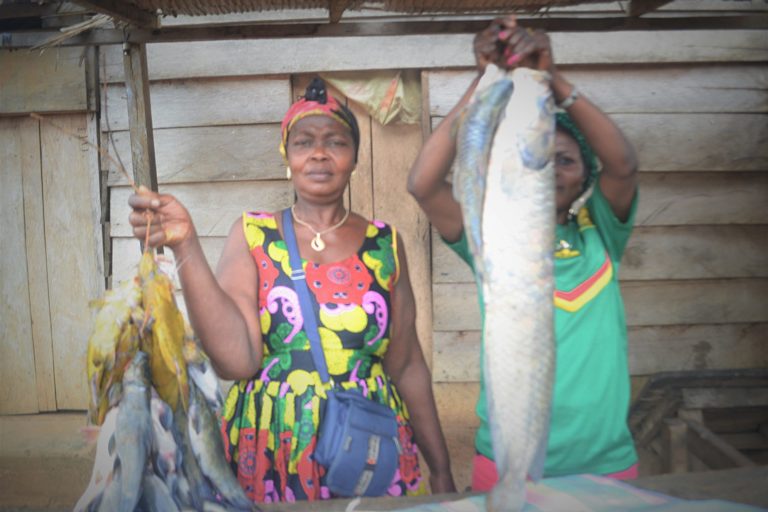 Fishmongers in the Ndji village marketplace don’t need much to get by. Image by Yannick Kenné.
Fishmongers in the Ndji village marketplace don’t need much to get by. Image by Yannick Kenné.
Read more: The world’s dams: Doing major harm but a manageable problem?
Lost income and “insignificant” compensation
In Batchenga’s Ndji village, located next to the dam, the atmosphere is a tad gloomy. Louise Elisabeth Messina, 42, got up early on Thursday August 11, to clean her house built from makeshift materials. Her day will continue in a field where she works almost daily in subsistence agriculture.
This fishmonger-restaurateur has now reverted to farming since the Nachtigal dam construction began in 2019. She had been a successful fishmonger for 14 years but hadn’t been able to practice for four years, causing her much distress.
“Fishermen would go fishing on the river,” reminisces Louise Elisabeth Messina. “They sold us their fish, which we resold fresh or dried, at the Obala market (about 27 kilometers or 16 miles from the village) or used it to make Ndomba (fish wrapped in banana leaves). Thanks to this business, I made on average $303 (200,000 CFA Francs) per week.”
It now takes her one season of very unpredictable harvests to earn the same amount.
Another fishmonger-restaurateur in the village, Marie-Claire Mendjane, 52, is still attached to being a fishmonger despite the fact that it is not as promising as it used to be and has built a makeshift diner in front of her home.
“The dam has had a big impact on our business,” she says.
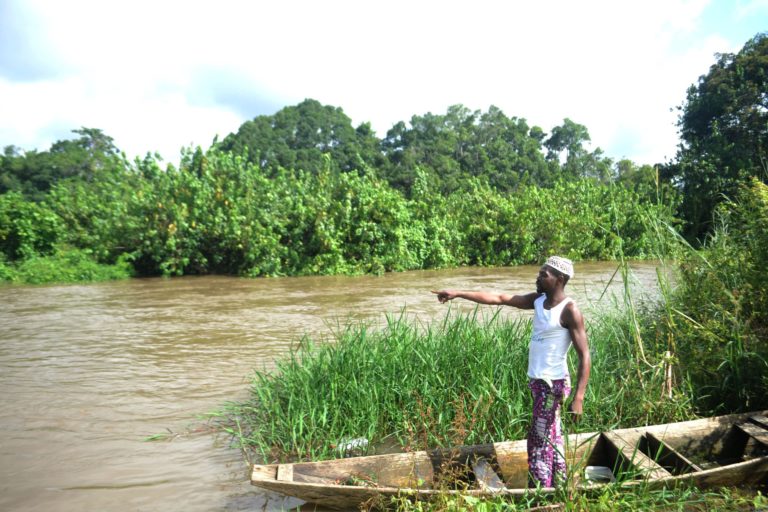 Alain, a fisherman from Ndji village, thinks that the lack of fish in the “central barrier” basin is due to the dam construction blocking the water, preventing species’ migration. Image by Yannick Kenné.
Alain, a fisherman from Ndji village, thinks that the lack of fish in the “central barrier” basin is due to the dam construction blocking the water, preventing species’ migration. Image by Yannick Kenné.
“I used to buy fish from the fishermen and make meals to sell at the Batchenga sand quarry twice a day. We don’t have the same income anymore. I used to make a daily profit of at least $15 (10,000 CFA Francs). Now it’s complicated, and the income fluctuates. There are days when I struggle to save $3 a day, and sometimes I make half of what I was earning before.”
In Batchenga, the local economy was based mainly on small-scale fishing and sand-mining quarries. The dam’s arrival put an end to these activities in Ndji village, Minkouma and Ndokoa-Ekombitié in Haute-Sanaga, as well as in Bindandjengue village, located between Haute-Sanaga and Mbam-et-Kim.
Alain, a fisherman from Ndji village, thinks that the lack of fish in the basin is due to the dam construction blocking the water, preventing species’ migration.
Various professional bodies representing the impacted fishermen, fishmongers, sand miners, and restaurateurs have made it their number one priority to campaign for reparations for the damages caused in recent years. These include the Association of Fishermen of Nkol-Ndji and Batchenga (APEN.NBA), established in 2015 to better represent the interests of fishermen and fishmongers in Ndji village.
Jean Wilfried Eyebe is the coordinator. On June 3, 2019, he sent a letter to NHPC general management in Yaoundé. In this correspondence, professional bodies representing fishermen and fishmongers requested compensation of up to $15,000 (10 million CFA Francs) per year for three years, and $7,500 (5 million CFA Francs) per year for three years.
 Sand miners, Malian nationals, busy on the “Central Barrier” site keeping the quarry in operation. Image by Yannick Kenné.
Sand miners, Malian nationals, busy on the “Central Barrier” site keeping the quarry in operation. Image by Yannick Kenné.
“Initially, our company rep offered us $456 per fisherman per year. After negotiations, it was raised to about $2,300 and an official report was signed in December 2021. We still had to put pressure on the company to finally pay us this money in July 2022,” reveals Jean Wilfried Eyebe.
The negotiations took time, and on July 14, 2022, they finally resulted in compensation for all the people affected by the project. Instead of the $46,000 owed to the fishermen over three years, the company only paid them $2,300; fishmongers received nearly $1,300, and restaurant owners received $1,140.
Following these payments, the NHPC company says it will also “support the transition to income-generating activities.” The company told Mongabay the compensation report stipulates that “acceptance without reservation by the beneficiary of the compensation amount” means community members claim more compensation relating to the impact on fishing.
For this fishermen and fishmonger compensation payout, the company says it has paid just over $334,000. This is barely 3% of the overall $14.368 million budget, allocated over ten years to implement the Environmental and Social Management Plan (ESMP), set out in the environmental impact study by the Franco-Canadian consortium Sogreah-Aecom, with the assistance of the Cameroonian design office ERE Development.
NHPC faces backlash from civil society organizations
However, the company paying these sums seen as “insignificant” does not absolve the community members of the complaints they have made against NHPC. Local communities have been assisted by a coalition of civil society organizations called IFI Synergy, based in Yaoundé, whose mission is to ensure that the rights of Indigenous and local communities are respected when projects financed by international financial institutions are implemented in Cameroon.
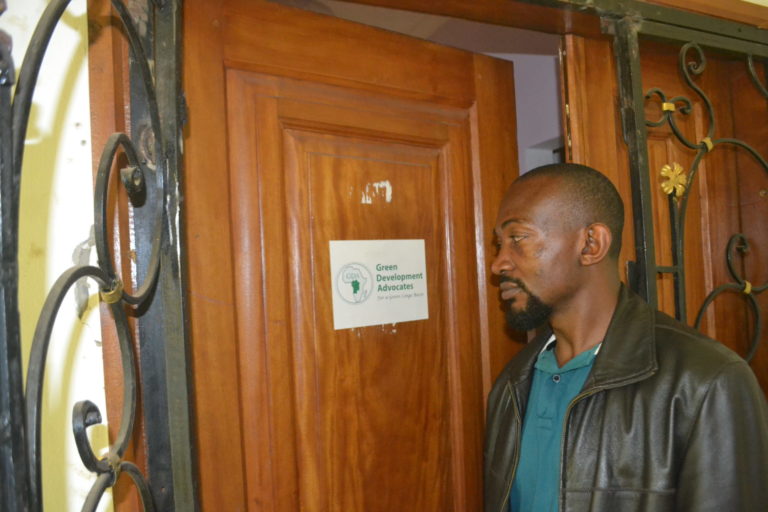 Ekane Nkwelle of the NGO Green Development Advocates (GDA). Image by Yannick Kenné.
Ekane Nkwelle of the NGO Green Development Advocates (GDA). Image by Yannick Kenné.
Since 2019, the group has been working alongside the communities impacted by the Nachtigal dam project to get the terms changed. On June 17, 2022, it submitted a complaint on behalf of local communities to the African Development Bank (ADB), one of the project’s financial partners, laying out the project’s damage to the environment and local residents. IFI Synergy has also informed other donors about the complaints to NHPC, but they have been less responsive.
Mongabay obtained a statement from Électricité de France (EDF), the project’s majority shareholder with 40% of shares. According to Jessica Gonçalves, press officer at EDF, NHPC “implements an ambitious environmental and social policy, in particular, to benefit local communities, who the project’s shareholders and lenders are closely associated with.”
Despite NHPC’s shortcomings in delivering on its biodiversity protection commitments, it has already been issued with a certificate of compliance with environmental obligations (AROE) by the Department of the Environment on four occasions, the last of which was issued on November 24, 2021.
Obtaining this valuable document depends on meeting a number of criteria the NHPC company has previously done, the Department of the Environment confirmed.
“If the company achieves an 80% implementation rate after this evaluation, the Department issues the compliance certificate (AROE). NHPC regularly receives these certificates, which means that it complies with its obligations,” the department tells Mongabay.
 Construction of a cofferdam, in its fourth phase on the Nachtigal dam site. Image © NHPC.
Construction of a cofferdam, in its fourth phase on the Nachtigal dam site. Image © NHPC.
Professor Serge Hubert Zebaze is a biodiversity specialist and lecturer in hydrobiology at the University of Yaoundé I in the Cameroonian capital. He regularly carries out consultations on developing environmental and social impact studies for similar projects. However, he has highlighted some shortcomings in the Nachtigal dam’s environmental impact study.
“The main aim of the environmental impact study is to offer people a sustainable activity. This study contains what we call elements of compensation for negative factors, which nothing can be done about,” he explains.
“In the dam’s environmental and social impact study, I noted two shortcomings: there are no names listed for who is responsible for compensation. Maybe the regulator (the government) didn’t pay attention, but I think this omission is misleading; the second thing is that the sustainability of the relocation was not considered because paying fishermen 1.5 million, even over 10 years, is not a lot. What we should have done was relocate them in a specific site that has the potential for sustainable development,” he analyses.
In terms of small-scale fishing, the environmental and social policy advocated by EDF has not been effectively implemented, argues Ekane Nkwelle, from the NGO Green Development Advocates (GDA), part of the IFI Synergy coalition.
 Fishing in the “Central Barrier”, downstream from the dam, is dwindling due to the scarcity of fish. Image by Yannick Kenné.
Fishing in the “Central Barrier”, downstream from the dam, is dwindling due to the scarcity of fish. Image by Yannick Kenné.
“So far (September 2022), there has been no action plan for fishing,” he says. “The Department of Livestock, Fisheries and Animal Industries claims that the plan is underway, but fishermen have had no access to water since 2018. They have lost everything and no longer have a source of income. In short, the livelihood restructuring plan is almost non-existent.”
Marthe Mebounou disagrees. Mebounou is a Department of Livestock, Fisheries and Animal Industries representative in Lekié, which includes Batchenga in its jurisdiction.
“Most of these fishermen were fishing for extra income and not for commercial purposes. They can’t then complain about lost income caused by the dam,” she states, accusing fishermen in the dam area of carrying out illegal small-scale fishing. “You also need to hold a fishing license to carry out fishing activity. The last fishing permit I issued in my department dates back to 2018.”
In Cameroon, fishing falls into four categories: maritime small-scale fishing, inland small-scale fishing, industrial fishing and fish farming. However, fishing is usually carried out informally, with small-scale fishing dominating in rivers and reservoirs of dams. Production rates are low, valued at 15,000 tonnes in 2020 according to Cameroon Department of Commerce statistics.
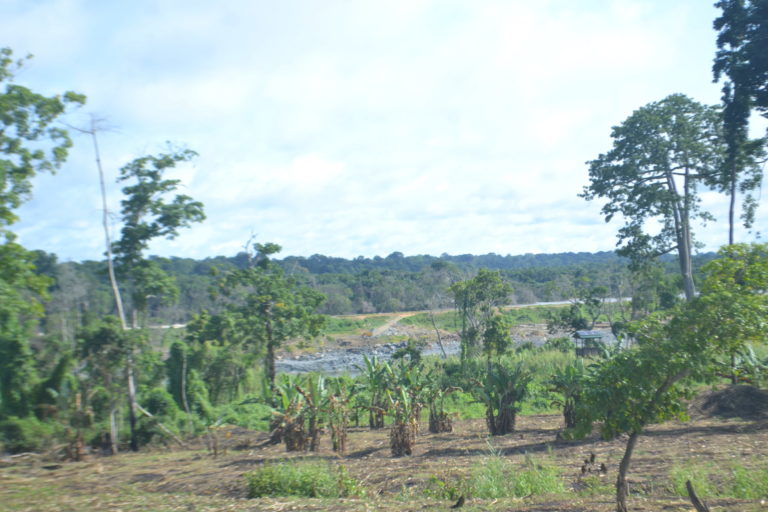 A stone quarry in operation at the dam, providing materials for the dam’s construction. Image by Yannick Kenné.
A stone quarry in operation at the dam, providing materials for the dam’s construction. Image by Yannick Kenné.
In 2021, national fish production reached just under 100,000 tonnes, while the national demand for fish products is estimated at more than 500,000 tonnes, according to the Department of Livestock, Fisheries and Animal Industries. To make up for this shortfall, Cameroon is forced to import fish every year. In 2021, the Department of Livestock authorized imports of nearly 250,000 tonnes of fish.
Creating a fishing ground to revive the industry
As a contribution to the revival of fishing in Batchenga and the local area, last July the NHPC company announced the creation of a fishing zone in the tributaries of the Sanaga River and the Mpem and Djim National Park in Mbam-et-Kim, about a hundred kilometers from the dam site.
In the project’s environmental and social impact study consulted by Mongabay, 65 fish species were listed, including three facing extinction, while four are vulnerable species.
The Nachtigal Hydro Power Company ensures that it is considering an impact mitigation strategy for these species. This strategy provides for “adaptive management of the environmental flow, implementation of rescue techniques when the waters recede, management of invasive plants in the reservoir, maintenance of vegetation on the riverbanks and sustainable management of fishing in the reservoir,” the company assures.
An expert was also recruited recently to develop this plan and will present the first report on the project by the end of 2022.
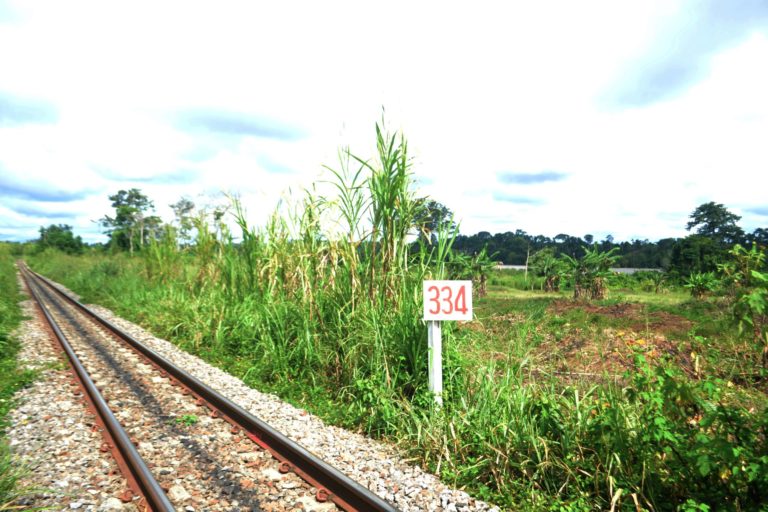 The railway line at Pkassala borders the project area. Image by Yannick Kenné.
The railway line at Pkassala borders the project area. Image by Yannick Kenné.
Banner image: Fishmongers in the Ndji village market get by with very little. Image by Yannick Kenné.
Related listening from Mongabay’s podcast: Two technologies being promoted as climate solutions, biomass and hydropower, actually have big environmental consequences and might not be sustainable at all. Can we burn and dam our way out of the climate crisis? Listen here:
Featured Image: Gold mine in South Kivu, Congo Image courtesy of the Sasha Lezhnev Enough Project.
Biodiversity, Clean Energy, Climate Change, Climate Change And Biodiversity, Climate Change and Dams, Conservation, Dams, Deforestation, Energy, Environment, Fish, Fishing, Freshwater Animals, Freshwater Fish, Green Energy, Hydroelectric Power, Hydropower, Renewable Energy, Rivers, Water, Water Scarcity
Africa, Cameroon, Central Africa
Source link : https://news.mongabay.com/2022/10/largest-of-its-kind-dam-in-cameroon-faces-backlash-from-unimpressed-fishmongers/
Author :
Publish date : 2022-10-13 07:00:00
Copyright for syndicated content belongs to the linked Source.




